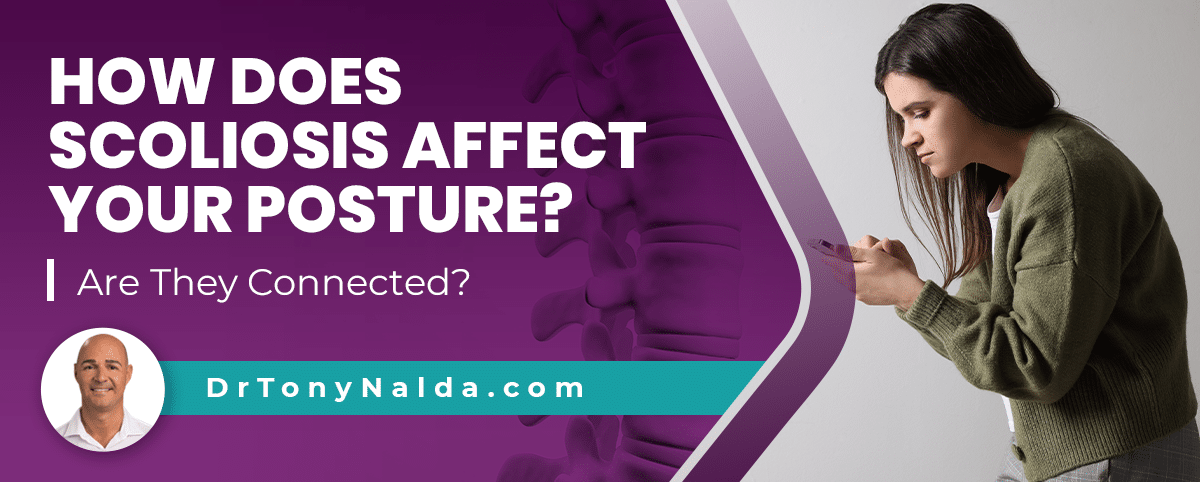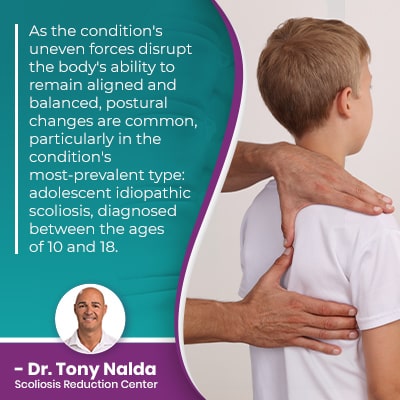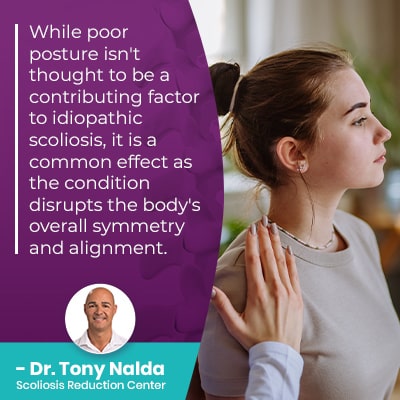How Does Scoliosis Affect Your Posture? Are They Connected?

Scoliosis is a complex condition that has a progressive nature, meaning it's going to get worse over time. When it comes to posture, this is the main symptom of scoliosis in children; in adults, the main symptom is pain, and this is because scoliosis becomes a compressive condition once skeletal maturity has been reached.
Scoliosis is a structural spinal condition that can affect the body in a number of ways. As the condition involves the development of an unnatural spinal curve, it introduces a lot of uneven forces to the body, which can disrupt its overall symmetry; this is how scoliosis affects your posture.
Before getting to the specifics of how scoliosis affects posture and why, lets first address what's happening inside the body of a patient recently diagnosed.
Table of Contents
What Does a Scoliosis Diagnosis Mean?
A diagnosis of scoliosis means that an unnatural sideways spinal curve that also rotates has developed, and it's the rotational component that makes scoliosis a 3-dimensional condition.
Being diagnosed with scoliosis also means that where a scoliosis is at the time of diagnosis, in terms of severity, doesn't mean that's where it will stay; scoliosis is progressive so has it in its very nature to worsen over time.
Scoliosis needs to be treated proactively in the interest of preventing progression, increasing condition effects, the need for invasive surgical treatment in the future, and making treatment success more likely.
While no treatment results are ever guaranteed, the earlier in a condition's progressive line treatment is started, the fewer limits there are, and this is because scoliosis only gets more complex to treat the more it progresses.
Part of diagnosing scoliosis involves comprehensively assessing it and classifying it based on key patient/condition variables such as patient age, curvature location, condition type, and severity.
Now, when we're talking about how the condition can affect posture, condition severity is a key factor.
How Bad Can Scoliosis Get?
No two cases of scoliosis are the same, which is why the condition's complex nature necessitates the customization of effective treatment plans.
Scoliosis severity is determined by a measurement known as Cobb angle, and a patient's Cobb angle is determined during X-ray by drawing lines from the tops and bottoms of the curve's most-tilted vertebrae, and the resulting angle is expressed in degrees.
Scoliosis severity ranges from mild to moderate and severe to very severe:
- Mild scoliosis patients have a Cobb angle measurement of between 10 and 25 degrees
- Moderate scoliosis patients have a Cobb angle of between 25 and 40 degrees
- Severe scoliosis patients have a Cobb angle of 40+ degrees
- Very-severe scoliosis patients have a Cobb angle of 80+ degrees
So how a condition is affecting a patient's body is going to change over the years, particularly based on how a diagnosis is responded to with treatment.
Now that we've touched on what is happening to a scoliotic spine and its progressive nature, let's look specifically at how the condition can affect posture.
Scoliosis and Posture
 When the spine deviates from a straight and neutral alignment, not only have certain vertebrae (bones of the spine) shifted out of alignment with the rest of the spine, the body's center of gravity is also shifted, which is why scoliosis is also associated with changes to balance, coordination, and gait.
When the spine deviates from a straight and neutral alignment, not only have certain vertebrae (bones of the spine) shifted out of alignment with the rest of the spine, the body's center of gravity is also shifted, which is why scoliosis is also associated with changes to balance, coordination, and gait.
As the condition's uneven forces disrupt the body's ability to remain aligned and balanced, postural changes are common, particularly in the condition's most-prevalent type: adolescent idiopathic scoliosis, diagnosed between the ages of 10 and 18.
Scoliosis patients who are still growing are the most at risk for continued progression because although we don't know what causes the majority of cases to develop, we do understand what triggers scoliosis to progress: growth and development.
Approximately 80 percent of known diagnosed cases are classified as idiopathic scoliosis, meaning not clearly associated with a single-known cause, and the remaining 20 percent are associated with known causes: neuromuscular scoliosis, degenerative scoliosis, and congenital scoliosis.
Neuromuscular scoliosis is caused by the presence of a larger neuromuscular condition such as cerebral palsy, spina bifida, and muscular dystrophy.
Degenerative scoliosis is caused by natural age-related spinal degeneration, and congenital scoliosis is caused by a malformed spine that develops in utero.
Scoliosis can affect a patient's physical appearance by changing their posture, gait, and causing clothing to become ill-fitting; clothing is designed for symmetrical bodies.
Postural changes associated with scoliosis can vary from person to person but commonly include:
- Uneven shoulders
- Uneven shoulder blades
- Uneven hips
- The development of a rib cage arch
- An uneven waistline
- Arms and legs that appear to hang at different lengths
Scoliosis screening involves looking at a patient's posture to see if the condition's telltale early signs are present: uneven shoulders and hips, and while there are never treatment guarantees, with conditions that are detected early and treated proactively, there are fewer limits to what can be achieved.
Scoliosis can also disrupt posture by causing a related muscle imbalance; as an unnatural spinal curve pulls the spine's surrounding muscles in different directions, this can cause the muscles on one side to become stretched and loose from overuse, and the muscles on the other side to become weak from underuse, and this additional asymmetry can further exacerbate poor posture.
Scoliosis and Pain
 Another condition-effect that is likely to get worse alongside progression is pain, but this will differ based on patient age.
Another condition-effect that is likely to get worse alongside progression is pain, but this will differ based on patient age.
For young patients whose spines are still growing, scoliosis pain isn't a common effect, and this is because scoliosis doesn't become a compressive condition until skeletal maturity has been reached; the constant lengthening motion of a growing spine counteracts the compressive force of the unnatural spinal curve, and it's compression of the spine and its surrounding muscles and nerves that causes the majority of condition-related pain.
So for adults, the main symptom that brings them in to see me for a diagnosis and treatment is back pain, and pain that radiates into the extremities due to nerve compression, and the more the spine curves unnaturally and rotates, the more painful it's going to be, and the more painful conditions can become as they progress, as the spine becomes increasingly unstable.
And remember, there is also a certain amount of natural age-related spinal degeneration to be expected: another reason adult scoliosis is more painful than childhood scoliosis.
While poor posture isn't thought to be a contributing factor to idiopathic scoliosis, it is a common effect as the condition disrupts the body's overall symmetry and alignment.
Conclusion
The best way to minimize condition-effects is to treat scoliosis proactively, and here at the Scoliosis Reduction Center, my patients benefit from a proactive conservative treatment approach.
Treating scoliosis proactively means a focus of treatment is on preventing progression, increasing condition effects, and the need for invasive surgical treatment by starting treatment as close to the time of diagnosis as possible.
When conditions are diagnosed early in their progressive lines, they are mild and likely to be the most responsive to treatment; progression increases spinal rigidity and makes the spine less responsive to treatment, and as scoliosis progresses, its related effects also increase.
Being proactive with treatment is the best way to minimize the condition's potential effects, and in children, that's postural deviation in the form of uneven shoulders and hips.
Scoliosis disrupts the body's overall symmetry so posture is also disrupted, and this causes changes to balance, coordination, and gait, making scoliosis-effects visual and noticeable, particularly if severe and/or if left untreated.
The best way to improve a patient's posture is through treatment that, first and foremost, impacts it on a structural level; scoliosis is a structural condition, and this is worked towards through condition-specific chiropractic care.
Once structural results are achieved, the focus can shift to increasing a patient's core strength through physical therapy and scoliosis-specific exercises so the spine's optimally supported, posture is improved, and certain areas of the brain are stimulated for improved brain-body communication.
Corrective bracing can help augment corrective treatment results by pushing the spine into a corrective position, and rehabilitation can involve continued chiropractic care and custom-prescribed home exercises to further stabilize and heal the spine.
There are three main sections of the spine, and scoliosis can affect any: cervical spine (neck), thoracic spine (middle/upper back), and the lumbar spine (lower back).
Here at the Center, I treat the whole spine and address all of the condition's effects: posture included.
By impacting the condition on all levels, postural deviation is addressed as a symptom because its underlying cause, the condition itself, is also being addressed, and as a curvature reduction is achieved, the condition's uneven forces are also reduced, and this improves related affects such as poor posture.
Dr. Tony Nalda
DOCTOR OF CHIROPRACTIC
After receiving an undergraduate degree in psychology and his Doctorate of Chiropractic from Life University, Dr. Nalda settled in Celebration, Florida and proceeded to build one of Central Florida’s most successful chiropractic clinics.
His experience with patients suffering from scoliosis, and the confusion and frustration they faced, led him to seek a specialty in scoliosis care. In 2006 he completed his Intensive Care Certification from CLEAR Institute, a leading scoliosis educational and certification center.
About Dr. Tony Nalda
 Ready to explore scoliosis treatment? Contact Us Now
Ready to explore scoliosis treatment? Contact Us Now





